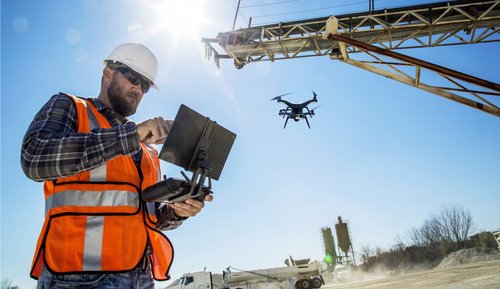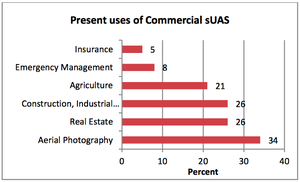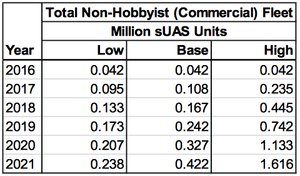
You know a particular sector must be new to the market when even the analysts predicting its record growth forget to include it in the highlights of their annual report. Such is the case this month with the Federal Aviation Administration‘s latest annual aerospace forecast, which waits until page 32 to reveal that the US fleet of unmanned commercial aerial systems (UAS), also known as drones, will likely grow 10 times larger between 2016 and 2021.
Granted, this is the first time that category has been included in the FAA’s 20-year forecast, which was released March 21 and covers fiscal years 2017–2037. Still, the decidedly bullish projection for drones in an otherwise unremarkable outlook for general aviation is noteworthy, especially for the construction and real estate sectors. After regulatory relaxation last spring, registrations for commercial-use waivers have climbed steadily at a rate of 1,000 per week. The FAA expects that trend to accelerate.
“The commercial drone sector is very dynamic and appears to be at an early stage of growth,” reads the new FAA report. “[The agency] forecasts that the non-hobbyist fleet by 2021 will likely [base scenario] be 10X larger than the size of the fleet in 2016. … FAA projects the number of units in the commercial small UAS fleet will exceed 420,000 by 2021, compared to 42,000 in 2016.”


Ceilings, floors & caveats
Of note, the “base scenario” refers to the midrange, most likely outcome. The FAA also offered a wider range of possibilities, from a low of 238,000 units to a high of 1.6 million by 2021.
“In 2017, it is likely that [drones] will be on every construction site,” says Kevin Sartori, a robotics engineer with Berkeley, CA-based 3D Robotics, which Autodesk invested in last summer. Sartori made his prediction in January, writing in Construction Executive magazine.
One indicator of such growth has been the rise in remote pilot certification, which began a steep ascent last June after the FAA issued part 107, its new set of rules for non-hobbyist sUAS operations. To date, according to the organization’s report, “the FAA has issued more than 29,000 Remote Pilot Certificates. Over 90% of individuals who took the part 107 aeronautical knowledge exam passed, as of February, 2017.”
Of course, given the political murkiness of the moment in the US and elsewhere, the FAA also issued several disclaimers with its predictions. Chief among them is this paragraph:
The baseline forecast assumes some level of tax cuts and additional infrastructure spending to the U.S. economy with the new Administration. However, there is considerable uncertainty as to the magnitude, timing, and nature of these programs which ultimately determines the impact on the future growth of the U.S. economy. In addition, there is still much to be worked out on how the U.S. will engage with the rest of the global economy over the next several years. Under the right conditions, a period of sustained high and more inclusive growth, along with increased financial stability could occur … but there is also the possibility of an outcome that leads to greater global economic fragmentation, slower growth, and increased financial instability.
While such hedging may leave much of these predictions up in the air, the trends for commercial drone use all still point in the same direction—up. Whether used for remote inspection, safety monitoring, aerial photography, or even equipment delivery, the devices are definitely finding a receptive audience. Those who traffic in data analytics are particularly enthused.
“As the drone industry grows, professionals who spend hundreds of hours collecting field data and measurements will increasingly turn to drone-based surveying techniques,” predicted Uplift data analyst Josh Arneson, writing earlier this year on the firm’s blog. “We’ve seen some intense discussions as to whether or not drones and aerial surveying will replace the role of traditional surveyors, [but] we firmly believe that instead of replacement, drones will become another tool in the surveyor’s tool belt.”

Discussion
Be the first to leave a comment.
You must be a member of the BuiltWorlds community to join the discussion.